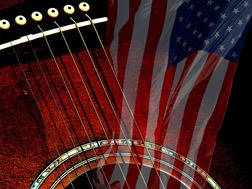
The American Way (Leaving Home: Orchestral Music in the 20th Century. Volume 5.) 1997
Distributed by Films Media Group, PO Box 2053, Princeton, New Jersey 08543-2053; 800-257-5126
Produced by RM Associates
Director n/a
VHS, color, 52 min.
High School - Adult
Music
Date Entered: 11/09/2018
Reviewed by Brad Eden, Ph.D., Head, Web and Digitization Services, University Libraries, University of Nevada, Las VegasThis video is the fifth in a seven-volume series introducing the music of the twentieth century to the public. Volume 5 deals with American music and the influence of American composers and compositions on trends and styles in twentieth century music. Simon Rattle follows the "conducted tour" approach used in other volumes of this series, where the City of Birmingham Symphony Orchestra performs a number of pieces, which Rattle discusses and conducts. In this volume, scenes of American life are shown throughout, from New York skyscrapers to the fall season in New England.
A number of interesting composers and compositions are featured: Gershwin's Rhapsody in Blue; Charles Ives's Decoration Day (1912); Elliott Carter's Celebration of some 100 x 150 notes (1987); Copland's Appalachian Spring (1944); Kurt Weill's Street Scene (1947); Leonard Bernstein's West Side Story/Symphonic Dances (1964); John Cage's First Construction in Metal (1939); Morton Feldman's Madame Press Died Last Week at age 90 (1970); Terry Riley's In C (1964); and John Adam's Harmonium (1981). This eclectic slice of America's contribution to music in the twentieth century is wonderfully explained by Rattle, from Gershwin's unique combination of Bessie Smith's wail and Jewish cantor music in the opening of Rhapsody in Blue, to Cage's use of prepared piano, to the closing performance of Adam's Harmonium, where the idea of the sea as the mother of us all and the concept of sexual ecstasy is combined through use of choral and orchestral techniques using the poetry of Emily Dickinson.
Rattle makes an interesting statement at the beginning of this video: that the European classical music tradition can be equated with a slow cooked casserole, while the American classical music tradition can be equated with a fast, brilliant stir fry. I think that this aptly describes how the variety of cultures and peoples in America have produced the eclectic and unique musical compositions of 20th century America. As a musicologist, I found this video an exciting and compact introduction for both music students and the general public on 20th century American music.